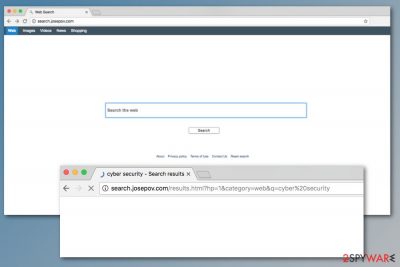Search.josepov.com (Virus Removal Instructions) - Tutorial
Search.josepov.com Removal Guide
What is Search.josepov.com?
Search.josepov.com is a fake search engine claiming to offer improved search results

Search.josepov.com is a browser hijacker that spreads with the help of bundling.[1] After the installation, it changes browser’s settings, tracks various information related to users’ web activity, and cause browsing-related problems.
It seems that Search.josepov.com virus attacks Mac OS X users and their web browsers, including Google Chrome, Mozilla Firefox or Safari. After the successful infiltration, it changes the default search engine, the homepage and the new tab URL options to hxxp://search.josepov.com.
Also known as Josepov virus, the hijacker might install “helper objects,” which are either potentially unwanted programs (PUPs) or suspicious browser add-ons. Their task is to prevent possible changes to the system anytime when users try to change them back to normal ones.
Search.josepov.com browser hijacker along with its “helper objects,” tracks user-related information, for instance, visited URLs, IP addresses, keystrokes or search queries. Such data can include personally identifiable information, which may be later shared with third parties (including other cybercriminals).
However, the biggest concerns are related to Search.josepov.com redirect problems. This fake search tool redirects search queries to Yahoo, which is a legitimate service. However, the hijacker might interfere and force you to visit affiliate websites.
The problem with these sites is that they might belong to cyber criminals or scammers.[2] Therefore, you might become a victim, lose your personal files or credit card information. These redirects might occur when you click on a link in the search results page or specific ad.
Due to these reasons, security specialists recommend staying away from the content provided by the hijacker and remove Search.josepov.com from your startup page immediately. As we have mentioned, this PUP is designed to prevent users’ changes, so you may need to employ anti-malware software.
Scanning the system with FortectIntego can help to terminate all files, components and “helper objects” related to the hijacker. However, if you are willing to get rid of it manually, you can find the instructions at the end of the virus description.

The shady search tool might appear on the computer unnoticed
Search.josepov.com travels through the Internet with rogue installers of freeware and shareware. This technique is called “software bundling” and misuses the fact, that computer users often rush installation processes and tend to skip steps.
In these installers, all PUPs are marked as allowed by default and are hidden within “Advanced/Custom” settings. By skipping these installation steps, you give them indirect permission to install them.
To avoid Search.josepov.com hijack and installation of unwanted apps, you should carefully check each window of the “Advanced/Custom” installation and deselect all “optional downloads” in the installer. Keep in mind that “Recommended/Standard” settings do not include this feature. Thus, you should not use them.
Remove Josepov virus and suspicious search engine from Mac OS X
To delete Search.josepov.com entirely, you have to find the hijacker, its “helper objects” and other related components, and uninstall them. The manual removal guide below will show you where these entries might be located.
However, IT experts from LesVirus.fr[3] note that the majority of users fail with manual hijacker’s removal. Often people rush and overlook some malicious entries. As a result, their browser’s homepage remains hijacked.
In order to succeed, you should remove Search.josepov.com using anti-malware software. All you have to do is to scan the system with an updated tool and reset affected web browser.
You may remove virus damage with a help of FortectIntego. SpyHunter 5Combo Cleaner and Malwarebytes are recommended to detect potentially unwanted programs and viruses with all their files and registry entries that are related to them.
Getting rid of Search.josepov.com. Follow these steps
Uninstall from Windows
Originally, the virus targets Mac operating system. However, if you found the hijacker on Windows computer, follow these steps to remove it:
Instructions for Windows 10/8 machines:
- Enter Control Panel into Windows search box and hit Enter or click on the search result.
- Under Programs, select Uninstall a program.

- From the list, find the entry of the suspicious program.
- Right-click on the application and select Uninstall.
- If User Account Control shows up, click Yes.
- Wait till uninstallation process is complete and click OK.

If you are Windows 7/XP user, proceed with the following instructions:
- Click on Windows Start > Control Panel located on the right pane (if you are Windows XP user, click on Add/Remove Programs).
- In Control Panel, select Programs > Uninstall a program.

- Pick the unwanted application by clicking on it once.
- At the top, click Uninstall/Change.
- In the confirmation prompt, pick Yes.
- Click OK once the removal process is finished.
Delete from macOS
To remove Search.josepov.com from the system, you have to remove all questionable apps:
Remove items from Applications folder:
- From the menu bar, select Go > Applications.
- In the Applications folder, look for all related entries.
- Click on the app and drag it to Trash (or right-click and pick Move to Trash)

To fully remove an unwanted app, you need to access Application Support, LaunchAgents, and LaunchDaemons folders and delete relevant files:
- Select Go > Go to Folder.
- Enter /Library/Application Support and click Go or press Enter.
- In the Application Support folder, look for any dubious entries and then delete them.
- Now enter /Library/LaunchAgents and /Library/LaunchDaemons folders the same way and terminate all the related .plist files.

Remove from Microsoft Edge
Delete unwanted extensions from MS Edge:
- Select Menu (three horizontal dots at the top-right of the browser window) and pick Extensions.
- From the list, pick the extension and click on the Gear icon.
- Click on Uninstall at the bottom.

Clear cookies and other browser data:
- Click on the Menu (three horizontal dots at the top-right of the browser window) and select Privacy & security.
- Under Clear browsing data, pick Choose what to clear.
- Select everything (apart from passwords, although you might want to include Media licenses as well, if applicable) and click on Clear.

Restore new tab and homepage settings:
- Click the menu icon and choose Settings.
- Then find On startup section.
- Click Disable if you found any suspicious domain.
Reset MS Edge if the above steps did not work:
- Press on Ctrl + Shift + Esc to open Task Manager.
- Click on More details arrow at the bottom of the window.
- Select Details tab.
- Now scroll down and locate every entry with Microsoft Edge name in it. Right-click on each of them and select End Task to stop MS Edge from running.

If this solution failed to help you, you need to use an advanced Edge reset method. Note that you need to backup your data before proceeding.
- Find the following folder on your computer: C:\\Users\\%username%\\AppData\\Local\\Packages\\Microsoft.MicrosoftEdge_8wekyb3d8bbwe.
- Press Ctrl + A on your keyboard to select all folders.
- Right-click on them and pick Delete

- Now right-click on the Start button and pick Windows PowerShell (Admin).
- When the new window opens, copy and paste the following command, and then press Enter:
Get-AppXPackage -AllUsers -Name Microsoft.MicrosoftEdge | Foreach {Add-AppxPackage -DisableDevelopmentMode -Register “$($_.InstallLocation)\\AppXManifest.xml” -Verbose

Instructions for Chromium-based Edge
Delete extensions from MS Edge (Chromium):
- Open Edge and click select Settings > Extensions.
- Delete unwanted extensions by clicking Remove.

Clear cache and site data:
- Click on Menu and go to Settings.
- Select Privacy, search and services.
- Under Clear browsing data, pick Choose what to clear.
- Under Time range, pick All time.
- Select Clear now.

Reset Chromium-based MS Edge:
- Click on Menu and select Settings.
- On the left side, pick Reset settings.
- Select Restore settings to their default values.
- Confirm with Reset.

Remove from Mozilla Firefox (FF)
Uninstall all suspicious add-ons or toolbars that might be related to Josepov and reset Firefox:
Remove dangerous extensions:
- Open Mozilla Firefox browser and click on the Menu (three horizontal lines at the top-right of the window).
- Select Add-ons.
- In here, select unwanted plugin and click Remove.

Reset the homepage:
- Click three horizontal lines at the top right corner to open the menu.
- Choose Options.
- Under Home options, enter your preferred site that will open every time you newly open the Mozilla Firefox.
Clear cookies and site data:
- Click Menu and pick Settings.
- Go to Privacy & Security section.
- Scroll down to locate Cookies and Site Data.
- Click on Clear Data…
- Select Cookies and Site Data, as well as Cached Web Content and press Clear.

Reset Mozilla Firefox
If clearing the browser as explained above did not help, reset Mozilla Firefox:
- Open Mozilla Firefox browser and click the Menu.
- Go to Help and then choose Troubleshooting Information.

- Under Give Firefox a tune up section, click on Refresh Firefox…
- Once the pop-up shows up, confirm the action by pressing on Refresh Firefox.

Remove from Google Chrome
Remove Google Chrome extensions that might be related to the hijacker and reset Chrome's settings to default.
Delete malicious extensions from Google Chrome:
- Open Google Chrome, click on the Menu (three vertical dots at the top-right corner) and select More tools > Extensions.
- In the newly opened window, you will see all the installed extensions. Uninstall all the suspicious plugins that might be related to the unwanted program by clicking Remove.

Clear cache and web data from Chrome:
- Click on Menu and pick Settings.
- Under Privacy and security, select Clear browsing data.
- Select Browsing history, Cookies and other site data, as well as Cached images and files.
- Click Clear data.

Change your homepage:
- Click menu and choose Settings.
- Look for a suspicious site in the On startup section.
- Click on Open a specific or set of pages and click on three dots to find the Remove option.
Reset Google Chrome:
If the previous methods did not help you, reset Google Chrome to eliminate all the unwanted components:
- Click on Menu and select Settings.
- In the Settings, scroll down and click Advanced.
- Scroll down and locate Reset and clean up section.
- Now click Restore settings to their original defaults.
- Confirm with Reset settings.

Delete from Safari
Follow these steps to fix Safari after the hijack:
Remove unwanted extensions from Safari:
- Click Safari > Preferences…
- In the new window, pick Extensions.
- Select the unwanted extension and select Uninstall.

Clear cookies and other website data from Safari:
- Click Safari > Clear History…
- From the drop-down menu under Clear, pick all history.
- Confirm with Clear History.

Reset Safari if the above-mentioned steps did not help you:
- Click Safari > Preferences…
- Go to Advanced tab.
- Tick the Show Develop menu in menu bar.
- From the menu bar, click Develop, and then select Empty Caches.

After uninstalling this potentially unwanted program (PUP) and fixing each of your web browsers, we recommend you to scan your PC system with a reputable anti-spyware. This will help you to get rid of Search.josepov.com registry traces and will also identify related parasites or possible malware infections on your computer. For that you can use our top-rated malware remover: FortectIntego, SpyHunter 5Combo Cleaner or Malwarebytes.
How to prevent from getting stealing programs
Stream videos without limitations, no matter where you are
There are multiple parties that could find out almost anything about you by checking your online activity. While this is highly unlikely, advertisers and tech companies are constantly tracking you online. The first step to privacy should be a secure browser that focuses on tracker reduction to a minimum.
Even if you employ a secure browser, you will not be able to access websites that are restricted due to local government laws or other reasons. In other words, you may not be able to stream Disney+ or US-based Netflix in some countries. To bypass these restrictions, you can employ a powerful Private Internet Access VPN, which provides dedicated servers for torrenting and streaming, not slowing you down in the process.
Data backups are important – recover your lost files
Ransomware is one of the biggest threats to personal data. Once it is executed on a machine, it launches a sophisticated encryption algorithm that locks all your files, although it does not destroy them. The most common misconception is that anti-malware software can return files to their previous states. This is not true, however, and data remains locked after the malicious payload is deleted.
While regular data backups are the only secure method to recover your files after a ransomware attack, tools such as Data Recovery Pro can also be effective and restore at least some of your lost data.
- ^ Product bundling. Wikipedia. The free encyclopedia.
- ^ Felicity Hannah. Fraudulent scams expected to rocket in 2018. The Independent. UK and worldwide news.
- ^ Les Virus. Les Virus. French security news.























